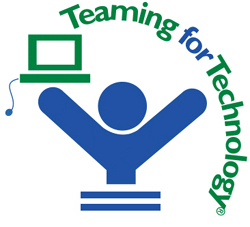
|
|
What Happened to Teaming for Technology?
Editor's note: We've tried for some time to learn more about whatever happened to Teaming for Technology. Unlike AOL's very public announcement of the dissolution of PowerUP and the studies that were available about its achievements and problems (see, for instance, "Findings from PowerUP's First Phase Evaluation"), the story about the ending/winding down of the IBM/United Way/Corporation for National and Community Service "Teaming for Technology" program collaboration has been less clear and public. We're grateful for former VISTA Diana Hauer's willingness to make some exploratory investigations and pleased we were able to obtain a copy of IBM's "Teaming for Technology—Business Plan, a work in Progress, May 2002," which sheds additional light on the initiative and deepens the mystery about what happened (for a copy of this report, email Danielle Martin). However that may be, Diana's report and the helpful supplement provided by Harold Smith, Director of CyberSkills/Burlington, provide an informative picture about what's happened and the transitions and new resources that are developing in its place. —pm In The Beginning
 The announced goal of the Teaming for Technology (T4T) program was to strengthen the technological capacity of nonprofits to: (1) increase their operational efficiency, (2) deliver their services more effectively, and (3) enhance their ability to leverage funds and other resources. To participate, agencies applied to their local T4T, and if they met certain criteria (IBM and United Way grant guidelines) a team of volunteers and technology professionals worked with them for one year, a "year of assistance." The T4T team worked with the agency to evaluate their needs and goals for agency improvement. Once the evaluation was complete, T4T created an individual technology plan for the next three-to-five years. The team then recruited community volunteers to help the agency fulfill the goals outlined in the plan. Agencies with the T4T technology plan often had more credibility with other grant programs because they had real, long-term goals to seek funding for and a sustainable structure in which to pursue them. A few of the T4T successes:
Changes
The eight pilot programs launched in 1997 increased 17 sites nationwide as the programs gained in popularity. These programs were not one-size-fits all: Each T4T reflected the "flavor” and needs of people in its area. Within the national framework, local T4T sites identified their own desired outcomes, activities, and partnerships to serve their communities. Some focused on technology planning, others emphasized computer recycling, and others specialized in software and hardware training. It was no surprise that these disparate approaches to technology programming could not be contained in a single program. In 2003 the national version of the Teaming for Technology program officially ended. Many T4T sites closed before then, or changed in ways that required them to leave the program. Some couldn’t provide strong enough outcome measurement results to justify continued funding, while others branched off and became 501c3’s in their own right. Some United Ways dropped the program because it didn’t meet their agency’s goals, while others branched out and grew into something greater than the original Teaming for Technology program. Seven of the original initiatives are still operating, either with the original United Way partner or with new funding and sponsorship/sites. Several programs still operate T4T programs in their communities, most notably in Chicago, Philadelphia, Colorado, and Minnesota. T4T Chicago is the only T4T that does not charge for its services and maintains a 250% return to the community for every dollar invested into the program. Their web site is frequently updated with technology-related articles and news for non-profit organizations, a useful resource even for those outside of their service area. Philadelphia’s T4T offers training, technology assistance, and digital inclusion programs for a nominal membership fee. T4T Coloradooffers technology planning assistance, computer training, and free and reduced cost referrals through theTechLaunch grant provided by IBM. Minnesota’s T4T has maintained its relationship with IBM (who provides technology and volunteers) and is connected fully with its United Way. North Carolina’s T4T is working under the Triangle United Way, operates a computer recycling and volunteer program, and has become the largest MAR (Microsoft Authorized Refurbisher) in the Southeast. Other currently-operating sites that were built upon T4T programs include The Georgia Center for Nonprofits in Atlanta and TechNews at New York City's United Way. The Future
In addition to the different agencies and programs that Teaming for Technology influenced in its six year run, it left a valuable legacy: Information. IBM’s employee/retiree volunteer program, On Demand Community (ODC), is a global program that makes technology-related solutions available for IBM employees and retirees to use to help community nonprofits and schools. One of the most popular is the Technology Planning solution, which includes eight tools that were developed through IBM’s work in T4T. This information can be accessed by IBM employees and used to assist nonprofits all over the world. Whether T4T continues in its disparate forms or all of its incarnations dissolve in the years to come, it did, and is still doing, a lot of good. Teaming for Technology’s work proved that non-profit organizations can successfully adapt and flourish in the digital world. That’s a heartening thought for everyone in the nonprofit tech community. All past and present IBM employees can access Technology Planning solutions and others through their intranet, so nonprofits should give special consideration to recruiting IBM people as volunteers. ODC can provide up to $3,500 in technology or $1,000 in direct money annually to a nonprofit or school if the IBM volunteer donates 40 hours within five months. Special thanks to Heidi Kraemer of IBM and Jenika Faes of the Chicago Teaming for Technology for contributing to this report.

Hyperlinks references in this article: Comments
|